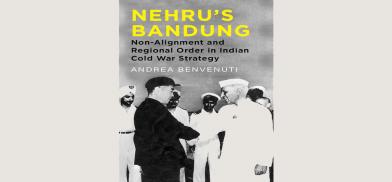Nehru's risky gamble on China that spectacularly backfired
Yet, despite Nehru’s disenchantment with his Afro-Asian partners, there is no denying that China did its best to undermine India’s ascendancy in the developing world and that Indian frustration with its northern neighbour grew all the more resentful because of New Delhi’s role in helping Beijing develop its links with other Afro-Asian nations.

On 18 April 1955, the first Asian-African conference opened in Bandung, a hill town 150 km southwest of Indonesian capital Jakarta. Among the 29 Afro-Asian leaders representing two-thirds of the world’s population, Indian Prime Minister Jawaharlal Nehru stood out as a particularly imposing figure. A global anti-colonial icon and a household name, he wielded significant international influence. The Asian-African conference was not his brainchild but that of Indonesian Prime Minister Ali Sastroamidjojo. However, by the time he reached Bandung, he had embraced the Indonesian idea, making sure that it conformed with India’s regional vision and goals.
Two key factors persuaded Nehru to overcome his initial reservations about such a conference. One factor was the Eisenhower administration’s decision to establish a regional defence alliance to deter further communist gains in Southeast Asia following France’s defeat in Indochina in May 1954. Nehru saw SEATO as dangerous because it threatened the Geneva Accords on Indochina and Sino-Soviet support for peaceful coexistence. The other factor was China’s embrace of peaceful coexistence. He perceived this shift in Chinese foreign policy as an excellent chance to secure Beijing's long-term commitment to regional peace and stability.
Nehru’s purpose in travelling to Bandung was to seize the opportunity accorded by the conference to promote his vision of a non-aligned Asia centred on “areas of peace” and the “five principles of peaceful coexistence”. According to Nehru, by choosing not to align with Cold War blocs and embracing the five principles as the basis of their non-aligned foreign policies, states could create “areas of peace” and secure regional stability. Moreover, he considered the Bandung Conference instrumental in cementing China’s commitment to peaceful coexistence and, as a result, thwarting Washington’s containment policy. Nehru’s agreement to hold an Asian-African conference in Bandung was not based on an emotional attachment to Afro-Asian internationalism. Instead, it was driven by his ambition to promote a “third way” in an increasingly polarised world and forge a more stable regional order that would bolster India’s external security and domestic prosperity.
Mixed results for Nehru
The Bandung Conference yielded mixed results for Nehru. Despite his hopes, his vision of a neutralised Asia failed to materialise. Non-communist delegations not only denounced communism but also questioned Nehru’s neutralism and expressed strong support for defensive alliances. The conference participants’ differing views on crucial Cold War issues highlighted India's challenges in seeking to lead an Afro-Asian grouping between superpower blocs. On the other hand, Nehru’s endeavours to engage China and persuade it to fully commit to peaceful coexistence appeared successful. Chinese Premier Zhou Enlai went a long way to reassure Afro-Asian leaders that China did not seek expansion and had no plans to subvert its neighbours.
Unfortunately for Nehru, the years that followed the Bandung Conference produced no less ambivalent results. On the plus side, SEATO neither became the aggressive tool of the American containment that Nehru had feared nor was it used to promote military interventions across Asia. Regional support for neutralism was on the rise, and this was the case even in those Asian countries that had chosen to align themselves with the West. Peaceful coexistence became the catchphrase for all diplomatic exchanges between Afro-Asian states, seemingly validating Nehru’s vision of a non-aligned Asia.
On the minus side, however, it was clear that proclamations of neutralist intent and adherence to the five principles were no indication that Asia had become or would ever become an “area of peace” free of Cold War tensions, as Nehru had envisioned. Nor did they amount to the kind of defence guarantee against regional threats he hoped for. What these proclamations often concealed was that the proponents of a neutralist “third way” were a diverse group who, despite a common desire for peace, had adopted neutralism for different reasons and, at times, even held significant misgivings about one other.
Misreading China
Indeed, one crucial component of Nehru’s neutralist Asian vision—namely, China’s commitment to peaceful coexistence—evaporated in October 1962 when China launched a sudden military attack across the disputed Sino-Indian border. In the crucible of war, Nehru tragically discovered how precarious the foundations of his vision were and how professions of neutralism and peaceful coexistence proved to be no insurance against Chinese aggression. He also realised how much he had misread the nature of Mao Zedong’s regime and its intentions. For the Chinese leadership, peaceful coexistence had only ever been a pragmatic and opportunistic response to the domestic and international circumstances of the mid-1950s. When Mao returned to a more radical vision of world politics based on class struggle, it was only a matter of time before Nehru’s assumptions would be put to the test. And when they were, he concluded that Chinese assurances were not worth the paper they were written on.
As misfortunes seldom come alone, the breakdown of the Sino-Indian relationship had another unfortunate consequence. By supporting China’s involvement in the Bandung Conference, Nehru paved the way for Beijing’s growing engagement with the Afro-Asian world. Although Beijing’s participation was a calculated move on Nehru’s part to turn China into a responsible regional power, his plans boomeranged. Beijing exploited the Afro-Asian movement to promote its revolutionary anti-imperialism and weaken Indian influence in the developing world.
To be sure, in the years following the Bandung Conference, Nehru no longer placed a high value on Afro-Asian solidarity to advance India’s national interests, given the Afro-Asian nations’ diverse agendas and persistent disagreements. As a result, India’s star lost some of its lustre (and influence) in the Afro-Asian and neutralist galaxy. Yet, despite Nehru’s disenchantment with his Afro-Asian partners, there is no denying that China did its best to undermine India’s ascendancy in the developing world and that Indian frustration with its northern neighbour grew all the more resentful because of New Delhi’s role in helping Beijing develop its links with other Afro-Asian nations. In short, China turned out to be a risky gamble that backfired spectacularly on Nehru.
(The author is an Associate Professor of Politics and International Relations, UNSW Australia. Article is excerpted from his book "Nehru’s Bandung: Non-Alignment and Regional Order in Indian Cold War Strategy; Hurst & Co. Publishers and Oxford University Press. He can be reached at Andrea.Benvenuti@unsw.edu.au )










Post a Comment